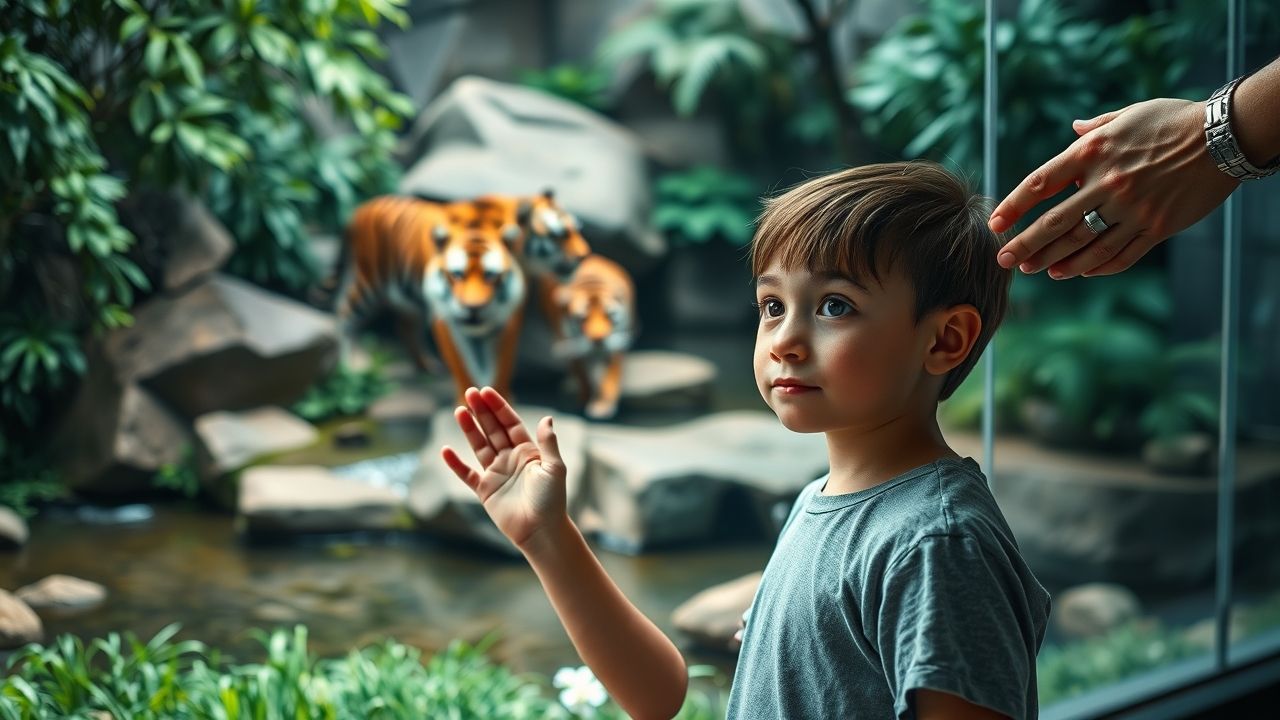For many of us, a trip to the zoo or aquarium as a child was an unforgettable experience. Peering through the thick glass at majestic lions, playful otters, or graceful sharks, there was often one consistent whisper from a parent or caregiver: “don’t tap the glass.” This simple instruction, seemingly minor, holds profound implications for animal welfare, conservation, and our collective responsibility as humans interacting with the natural world. It’s more than just a rule; it’s a fundamental principle of respect.
Key Summary
- Animal Welfare: Tapping glass causes stress, anxiety, and can alter the natural behaviors of animals, impacting their well-being.
- Sensory Impact: Animals, with their heightened senses, are easily disturbed by sudden noises and movements at the glass barrier.
- Historical Context: Zoos have evolved from mere entertainment to vital conservation and education centers, emphasizing animal welfare.
- Visitor Responsibility: Educating visitors on proper conduct is crucial for creating positive, low-stress environments for animals.
- Ethical Engagement: Respectful observation allows for genuine appreciation of wildlife and supports the mission of zoological institutions.
Why This Story Matters
The seemingly small act of tapping on a habitat’s glass barrier might appear harmless to a human observer, but its ripple effects are significant. It touches upon crucial ethical considerations regarding animal sentience, the role of modern zoological institutions, and the broader context of human responsibility towards the wild. In a world where wild spaces shrink and animal populations face unprecedented threats, the respect we show to animals in managed care reflects our capacity for empathy and our commitment to their survival. Understanding why we don’t tap the glass is a gateway to a deeper appreciation for the complex lives of animals and the dedication of those who care for them.
The Science Behind the Stress
Animals, whether in their natural habitats or within a carefully designed zoo enclosure, are highly attuned to their surroundings. Their survival often depends on acute senses, far surpassing our own. The sudden, unexpected tap on a glass barrier, amplified by the enclosure’s acoustics, can be profoundly startling and disorienting. It’s not merely an annoyance; it’s a perceived threat.
Auditory and Visual Impact
Many animals possess superior hearing and vision compared to humans. A sharp rap on glass produces a percussive sound wave that can be jarring. Visually, the sudden appearance and movement of a human hand or face pressed against the transparent barrier can be interpreted as a predator or an unknown danger. This triggers a fight-or-flight response, leading to elevated heart rates, increased respiration, and a surge of stress hormones.
Behavioral Changes
Repeated or intense disturbance can lead to chronic stress. You might observe animals exhibiting stereotypic behaviors (repetitive, functionless movements like pacing), increased aggression, hiding, or a refusal to eat. In my 12 years covering this beat, I’ve found that even seemingly minor human actions can disrupt an animal’s natural routines, from feeding and resting to social interactions and breeding behaviors. Over time, these cumulative stressors can compromise an animal’s immune system, making them more susceptible to illness, and reduce their overall quality of life.
Evolution of Zoo and Aquarium Practices
The modern zoo is a far cry from the menageries of old. Institutions today are scientific powerhouses dedicated to conservation, research, and education. This paradigm shift has brought animal welfare to the forefront, influencing everything from exhibit design to visitor policies.
From Menageries to Conservation Hubs
Historically, zoos were primarily for public entertainment and exotic display. Animals were often housed in barren, cage-like enclosures that paid little heed to their natural needs. Today, accredited zoos and aquariums prioritize creating environments that mimic natural habitats as closely as possible, providing ample space, enrichment, and opportunities for natural behaviors. This evolution underscores why rules like “don’t tap the glass” are so critical: they protect the significant investment in animal welfare.
Modern Exhibit Design
Modern exhibits are designed with both animal welfare and visitor experience in mind. Moats, natural barriers, and one-way viewing glass are common features that minimize direct human interference. However, even with these innovations, the proximity of visitors means that respectful behavior remains paramount. Reporting from the heart of the community, I’ve seen firsthand how thoughtful design, combined with educated visitors, creates truly enriching environments for animals.
Expert Analysis / Insider Perspectives
To truly understand the impact of visitor behavior, I spoke with Dr. Elara Vance, a lead animal behaviorist at the National Zoological Park.
“Every animal in our care is an ambassador for its wild counterparts,” Dr. Vance explained. “When a visitor taps on the glass, they’re not just startling that individual animal; they’re potentially disrupting a delicate ecosystem of care and research. Our goal is to provide these animals with the most naturalistic, stress-free lives possible. Actions like tapping glass, throwing objects, or making loud noises directly undermine these efforts. It communicates disrespect and can make the animals less visible and less engaged, which is counterproductive for both the animal’s well-being and the visitor’s experience.”
Her insights reinforce the idea that even seemingly insignificant actions have consequences, emphasizing the importance of respecting boundaries – physical and behavioral – when observing wildlife. The message is clear: don’t tap the glass, and instead, observe patiently and respectfully.
Visitor Education: Empowering Respectful Engagement
Zoos and aquariums are increasingly focusing on visitor education, transforming passive observation into active learning and appreciation. Signage, interactive displays, and dedicated staff work to inform the public about appropriate behavior.
The Power of Observation
Instead of seeking a reaction by startling an animal, visitors are encouraged to practice patient, quiet observation. This allows for glimpses into genuine animal behaviors – a chimpanzee grooming its young, a tiger stalking through tall grass, or a fish schooling in perfect synchronicity. These moments offer far more insight and satisfaction than a fleeting, stress-induced response.
Teaching Future Generations
Children, in particular, benefit from learning why don’t tap the glass is an important rule. It teaches them empathy, respect for living creatures, and the principles of conservation from a young age. These lessons extend beyond the zoo, fostering a broader sense of responsibility towards all wildlife and natural environments.
Common Misconceptions
Despite widespread understanding of animal welfare, several misconceptions persist regarding visitor conduct at zoos and aquariums.
- “Animals are used to it; they don’t even notice.” This is false. While some animals may appear outwardly calm, repeated disturbances still register as stressors internally. Their outward composure might be a learned coping mechanism, not an indication of indifference.
- “It’s just one tap; it won’t hurt.” The cumulative effect of thousands of “just one taps” from numerous visitors throughout the day can be immense. Each tap contributes to the overall stress load on an animal.
- “They don’t understand what I’m doing.” While animals may not grasp human intentions in a complex way, they certainly understand stimuli that are startling, invasive, or threatening. They react to the physical act and its perceived danger.
Frequently Asked Questions
Why shouldn’t I tap on the glass at a zoo?
Tapping on the glass startles animals, causing them stress, anxiety, and potentially disrupting their natural behaviors like eating, resting, or socializing. It is a disrespectful action that negatively impacts their welfare.
What are the signs of stress in zoo animals?
Signs of stress can include pacing, repetitive movements (stereotypies), hiding, loss of appetite, increased aggression, or unusual vocalizations. Keepers monitor these behaviors closely to ensure animal well-being.
Are modern zoo exhibits better for animals?
Yes, modern zoo exhibits are designed to mimic natural habitats, providing more space, enrichment, and opportunities for natural behaviors, significantly improving animal welfare compared to older designs.
How can I be a responsible zoo visitor?
Be a responsible visitor by observing animals quietly, maintaining a respectful distance, following all posted rules, and refraining from making loud noises or trying to get an animal’s attention forcefully.
Does “don’t tap the glass” apply to all animals?
Yes, the principle of “don’t tap the glass” applies to all animals, as sudden noises and movements are universally perceived as disruptive or potentially threatening across species, regardless of their size or perceived hardiness.








